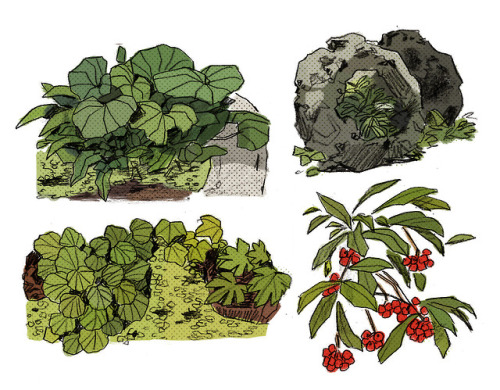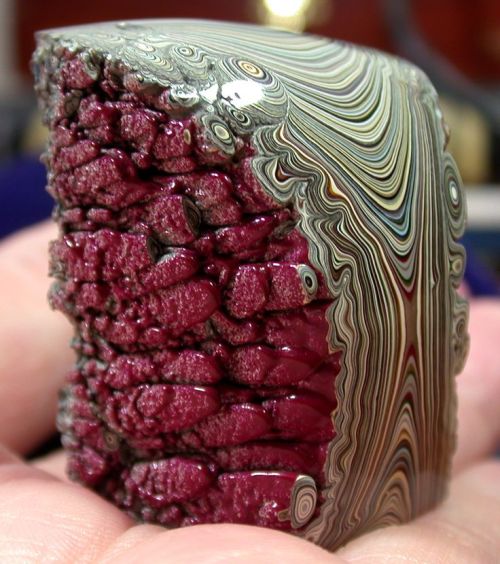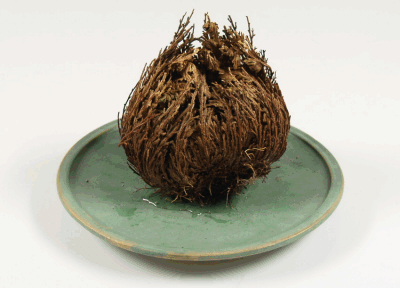As Cat Owners We Like To Joke About How The Cat Is The One Who’s Really In Charge, But Let’s Be Honest
As cat owners we like to joke about how the cat is the one who’s really in charge, but let’s be honest here: my cats think they’re in charge, but they’re also fucking dumbasses. It’s sort of an incompetent-king-and-long-suffering-advisor arrangement, if the king were prone to getting their head stuck in Kleenex boxes.
More Posts from Rocks-everywhere and Others
This radiant Sodalite mineral rock. Tenebrescence is the ability of minerals to change colour when exposed to light.
Source


a psa
Shocked quartz is not actually rainbow, those images are microscopic views of single shocked quartz particles! On a non-microscopic level, this is what it looks like.

A little bit mundane compared to those funky rainbow microscope shots if you’d ask me.


Fordite, also known as Detroit agate, is old automobile paint which has hardened sufficiently to be cut and polished. It was formed from the built up of layers of enamel paint slag on tracks and skids on which cars were hand spray-painted (a now automated process), which have been baked numerous times.
How is Biotechnology Preparing us to Live on the Moon and Mars?
The adventures awaiting astronauts on future long-duration missions have technologists researching sustainable ways to live away from Earth. We’re using what we know from almost 20 years of a continuous human presence on the International Space Station and looking at new technologies to prepare for extended stays on the Moon and Mars.

Biotechnology – technology that uses living organisms to make products that provide a new use – is key to this research.
With biotechnology, we’re developing new ways to manufacture medicines, build habitats and more in space. Here are some ways biotechnology is advancing spaceflight and how the same research is reaping benefits on Earth.

Healthy astronauts
Planning ways to supply food for a multi-year mission on the Moon or Mars may require making food and nutrients in space. Our scientists are testing an early version of a potential solution: get microorganisms to produce vital nutrients like those usually found in vegetables. Then, whenever they’re needed, astronauts can drink them down.
The microorganisms are genetically engineered to rapidly produce controlled quantities of essential nutrients. Because the microorganisms and their food source both have a long shelf-life at room temperature and only need water to be activated, the system provides a simple, practical way to produce essential nutrients on-demand. The same kind of system designed for space could also help provide nutrition for people in remote areas of our planet.
Our researchers are evaluating the first batches of BioNutrient samples that came back to Earth after an experimental run on the International Space Station.

Because space travel takes a toll on the human body, we’re also researching how biotechnology can be used to advance the field of regenerative medicine.
Related cells that are joined together are collectively referred to as tissue, and these cells work together as organs to accomplish specific functions in the human body. Blood vessels around the cells vascularize, providing nutrients to the tissue to keep it healthy.
Our Vascular Tissue Challenge offers a $500,000 prize to be divided among the first three teams that successfully create thick, metabolically-functional human vascularized organ tissue in a controlled laboratory environment. The vascularized, thick-tissue models resulting from this challenge will function as organ analogs, or models, that can be used to study deep space environmental effects, such as radiation, and to develop strategies to minimize the damage to healthy cells.
Plant factories
Humans have relied on plants’ medicinal qualities for thousands of years for everything from alleviating minor ailments to curing serious diseases. Now, researchers are trying to simplify the process of turning plants into medicine (i.e. how to make it compact and portable). If successful, the cost of biomanufacturing pharmaceuticals on Earth could go down, and plants could produce medicines in space.

Creating medicine on demand isn’t something we typically do, so we’re turning to experts in the field for help. Researchers at the University of California, Davis are transforming plants into mini-medicine factories for future Mars missions. They’re genetically altering an ordinary type of lettuce so that it produces a protein called parathyroid hormone. This hormone is an approved drug for treating osteoporosis, a common condition where bones become weak and brittle.

This type of research is vital to long duration spaceflight. When astronauts land on Mars, they’ll need to be strong—ready to explore. The length of the flight in zero gravity to get there and lower gravity on the surface could have a negative impact on human bones. Having the technologies needed to treat that possibility, and other unanticipated health effects of long duration spaceflight, is crucial.
Growing habitats
Vitamins aren’t the only thing astronauts could be growing on Mars; we’re exploring technologies that could grow structures out of fungi.
An early-stage research project underway at our Ames Research Center is prototyping technologies that could “grow” habitats on the Moon, Mars and beyond out of life – specifically, fungi and the unseen underground threads that make up the main part of the fungus. These tiny threads build complex structures with extreme precision, networking out into larger structures like mushrooms. With the right conditions, they can be coaxed into making new structures – ranging from a material similar to leather to the building blocks for a planetary home.
The myco-architecture project envisions a future where astronauts can construct a habitat out of the lightweight fungi material. Upon arrival, by unfolding a basic structure made up of dormant fungi and simply adding water, the fungi would grow around that framework into a fully functional human habitat – all while being safely contained to avoid contaminating the external environment.

Recycling waste
Once astronauts arrive on the surface of the Moon or a more distant planet, they’ll have to carefully manage garbage. This waste includes some stuff that gets flushed on Earth.
Today, we’re already using a recycling system on the space station to turn urine into drinking water. Poop on the other hand is contained then disposed of on spacecraft returning to Earth. That won’t be possible on more distant journeys, so, we’re turning to biomanufacturing for a practical solution.
Biology can serve as an effective recycling factory. Microorganisms such as yeast and algae feed on all kinds of things classified as “mission waste.” Processing their preferred form of nourishment generates products that can serve as raw materials used to make essential supplies like nutrients, medicines, plastic and fuel.

By taking a careful look at biological processes, we hope to develop new, lightweight systems to leverage that biology to do some helpful in-space manufacturing.
From Space to Earth
Biotechnology is preparing us for longer space missions to the Moon and then Mars – farther from Earth than humans have ever traveled before. As we prepare for those exciting missions, we’re also conducting research on the space station for the primary benefit of everyone on Earth.
January is National Biotechnology Month. To learn more about some of the ways NASA is using biotechnology to solve challenges in space and improve life on Earth, visit this link.
Make sure to follow us on Tumblr for your regular dose of space: http://nasa.tumblr.com




Geology collection, Museum of Natural History, London

A Rose of Jericho three hours after being watered having nearly returned to is previous, alive, state!
The Rose of Jericho(Anastatica hierochuntica) is a species of resurrection plant. These plants are characterized by their ability to use Poikilohydric mechanisms which enable them to survive extreme dehydration for years at a time.
me, to my friend, out of no where: You know whats fucked uP? the volcanology scale. Have i told you about the volcanic explosivity index?
my friend: no? What?!
me: Isnt it fun how catastrophic is only the halfway point on this exponential scale of eruption severity

When Dwarfs Meet Giants, and Other True Cosmic Fairy Tales
It’s easy to get lost in fantasy worlds through science-fiction movies and novels, but did you know that some of your favorite fairy tale characters actually exist in cosmic form? From dwarfs and giants to shape-shifters and buried treasure, the universe is home to a multitude of mystical objects.
White Dwarf Stars

You’ve probably heard of dwarfs like Happy and Sneezy (or Gimli and Thorin), but it’s unlikely you’re familiar with the space-dwelling dwarfs with names like Sirius B and ASASSN-16oh. White dwarf stars like these are typically about the size of Earth, which is pretty small as far as stars go. They represent one of three final stages of stellar evolution, along with neutron stars and black holes. Each star’s mass determines which one it will ultimately become. Stars much more massive than the Sun typically become neutron stars or black holes, and lower-mass stars end up as white dwarfs.

Our Sun will eventually become a white dwarf after it exhausts its fuel, but don’t worry — we’ve got several billion years to go! Before it is reduced to a white dwarf it will actually expand into a red giant, swelling out to encompass Earth’s orbit. But we don’t have to wait billions of years to see stellar giants … some already peek out at us from the cosmic deep.
Giants and Supergiants

The red giant star Aldebaran, located about 65 light-years away, is about 5,000 times bigger than Earth. Our Cassini spacecraft imaged Aldebaran through Saturn’s rings in 2006, but you can see it for yourself during northern winter. Just look for the brightest star in the constellation Taurus.

Fairy tale giants may be taller than trees, but these supergiant stars can be over 100,000 times “taller” than our entire planet! Supergiant stars are likely becoming more rare as time goes on. While scientists believe they used to be more common, our whole galaxy now contains just a small smattering of supergiants.

These massive stars grace the galaxy for a relatively small amount of time. They burn through their fuel extremely quickly — in just a few million years, as opposed to hundreds of billions of years for the smallest stars! Supergiants often end their lives in dramatic explosions called supernovae.

Betelgeuse — the bright, reddish star marking the shoulder of Orion — is nearing the end of its life and has expanded to become a red supergiant star. It is destined to explode as a supernova, which might happen tonight … or within the next few hundred thousand years.
Ghostly Solar Neutrinos

Even an average star like our Sun has some seemingly magical qualities. Each second, it sends billions of phantom-like neutrino particles out into space. They travel almost as fast as light and don’t usually interact with normal matter. Billions of them are zipping harmlessly straight through your body while you read this. Even at night they go through the entire Earth before reaching you!

But that’s not all … these ghostly particles are shape-shifters, too! Neutrinos can change characteristics over time, morphing between different versions of themselves. Spooky!
Buried Treasure in the Heart of the Galaxy

Extensive clouds of dust enshroud the heart of our Milky Way galaxy, hiding it from our view — at least when it comes to visible light. The dust isn’t as big a problem for infrared light, however, which has allowed us to get a glimpse of our galaxy’s chaotic core thanks to our Hubble and Spitzer space telescopes.

Future missions may peer into the galactic core in search of buried treasure — thousands of planets orbiting distant stars!
Want to learn about more cosmic objects? Find them here!
Make sure to follow us on Tumblr for your regular dose of space: http://nasa.tumblr.com
-
 jay1538 liked this · 2 weeks ago
jay1538 liked this · 2 weeks ago -
 ass-o-clockinthemorning liked this · 3 weeks ago
ass-o-clockinthemorning liked this · 3 weeks ago -
 bluecatpurrs reblogged this · 3 weeks ago
bluecatpurrs reblogged this · 3 weeks ago -
 colorfulpuppychaos liked this · 3 weeks ago
colorfulpuppychaos liked this · 3 weeks ago -
 itsfiredancer123 reblogged this · 3 weeks ago
itsfiredancer123 reblogged this · 3 weeks ago -
 sideoftheangels1 reblogged this · 4 weeks ago
sideoftheangels1 reblogged this · 4 weeks ago -
 atsa-canned-turnip reblogged this · 1 month ago
atsa-canned-turnip reblogged this · 1 month ago -
 ass-o-clockinthemorning reblogged this · 1 month ago
ass-o-clockinthemorning reblogged this · 1 month ago -
 leanmeanpintobean liked this · 1 month ago
leanmeanpintobean liked this · 1 month ago -
 dragonleighs reblogged this · 1 month ago
dragonleighs reblogged this · 1 month ago -
 epicdude365 reblogged this · 1 month ago
epicdude365 reblogged this · 1 month ago -
 wormdrobe liked this · 1 month ago
wormdrobe liked this · 1 month ago -
 ksanaob liked this · 1 month ago
ksanaob liked this · 1 month ago -
 g0ldengaytime reblogged this · 1 month ago
g0ldengaytime reblogged this · 1 month ago -
 g0ldengaytime liked this · 1 month ago
g0ldengaytime liked this · 1 month ago -
 lawldog liked this · 1 month ago
lawldog liked this · 1 month ago -
 the-sourwolfs-spark liked this · 1 month ago
the-sourwolfs-spark liked this · 1 month ago -
 albionraine reblogged this · 1 month ago
albionraine reblogged this · 1 month ago -
 z0mbdino liked this · 1 month ago
z0mbdino liked this · 1 month ago -
 thingummies-and-whatsits reblogged this · 1 month ago
thingummies-and-whatsits reblogged this · 1 month ago -
 moose-of-the-bog reblogged this · 1 month ago
moose-of-the-bog reblogged this · 1 month ago -
 moose-of-the-bog liked this · 1 month ago
moose-of-the-bog liked this · 1 month ago -
 antiqua-lugar liked this · 1 month ago
antiqua-lugar liked this · 1 month ago -
 jumpin--bean reblogged this · 1 month ago
jumpin--bean reblogged this · 1 month ago -
 jumpin--bean liked this · 1 month ago
jumpin--bean liked this · 1 month ago -
 jeevesandwoosterfan reblogged this · 1 month ago
jeevesandwoosterfan reblogged this · 1 month ago -
 seventy5th liked this · 1 month ago
seventy5th liked this · 1 month ago -
 puzzledemigod reblogged this · 1 month ago
puzzledemigod reblogged this · 1 month ago -
 mousedetective liked this · 1 month ago
mousedetective liked this · 1 month ago -
 clusterbungle reblogged this · 1 month ago
clusterbungle reblogged this · 1 month ago -
 mindofmim reblogged this · 1 month ago
mindofmim reblogged this · 1 month ago -
 idontknowwhatimdoing101 reblogged this · 1 month ago
idontknowwhatimdoing101 reblogged this · 1 month ago -
 idontknowwhatimdoing101 liked this · 1 month ago
idontknowwhatimdoing101 liked this · 1 month ago -
 manorinthewoods liked this · 2 months ago
manorinthewoods liked this · 2 months ago -
 cyanideespresso reblogged this · 2 months ago
cyanideespresso reblogged this · 2 months ago -
 itsfiredancer123 liked this · 2 months ago
itsfiredancer123 liked this · 2 months ago -
 carverly reblogged this · 2 months ago
carverly reblogged this · 2 months ago -
 eclectichellmouth reblogged this · 2 months ago
eclectichellmouth reblogged this · 2 months ago -
 adrianblackwood liked this · 3 months ago
adrianblackwood liked this · 3 months ago -
 haveahearttinman reblogged this · 3 months ago
haveahearttinman reblogged this · 3 months ago -
 deepest-dope liked this · 4 months ago
deepest-dope liked this · 4 months ago -
 xxstikkybunnyxx liked this · 4 months ago
xxstikkybunnyxx liked this · 4 months ago -
 dorcaloveskotlc liked this · 4 months ago
dorcaloveskotlc liked this · 4 months ago -
 highborn-demon liked this · 4 months ago
highborn-demon liked this · 4 months ago -
 chronic-book-hangover reblogged this · 4 months ago
chronic-book-hangover reblogged this · 4 months ago
225 posts
